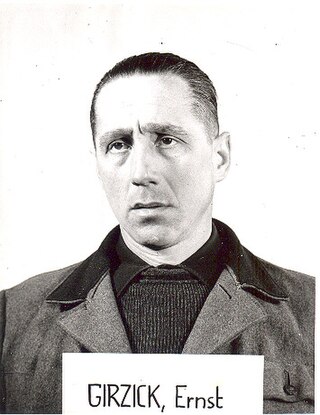Karl Fiehler was a German Nazi Party (NSDAP) official and Mayor of Munich from 1933 until 1945. He was an early member of the Nazi Party having joined in 1920. In 1933, he became a Reichsleiter in the party and was a member of the Reichstag. In March of 1933, he was appointed Mayor of Munich and held that post until the end of World War II in Europe. During his time as mayor, Fiehler was zealously anti-Semitic and saw to it that the Jewish population of the city was persecuted. After the war in January 1949, Fiehler was sentenced to two years in a labour camp, but the sentence was suspended given the previous three-and-a-half years of detention he had already served.

Die Rote Fahne was a German newspaper originally founded in 1876 by Socialist Worker's Party leader Wilhelm Hasselmann, and which has been since published on and off, at times underground, by German Socialists and Communists. Karl Liebknecht and Rosa Luxemburg famously published it in 1918 as organ of the Spartacus League.

Johannes Baptist "Hans" Beimler was a trade unionist, Communist Party official, deputy in the 1933 Reichstag, an outspoken opponent of the Nazis and a volunteer in the international brigades fighting for the Spanish Republic.
Max Frauendorfer was a German jurist and politician, representative of the NSDAP and the Christian Social Union of Bavaria.

Werner Scholem was a member of the German Reichstag in 1924 to 1928 and a leading member of the Communist Party of Germany. Scholem and his wife, Emmy, were portrayed in the 2014 documentary "Between Utopia and Counter Revolution".

The Association of Persecutees of the Nazi Regime – Federation of Antifascists (VVN-BdA) is a German political confederation founded in 1947 and based in Berlin. The VVN-BdA, formerly the VVN, emerged from victims' associations in Germany founded by political opponents to Nazism after the Second World War and the end of the Nazi rule in Germany.
Josef (Pepek) Taussig was a Czech journalist.

Ernst Adolf Girzick was an Austrian SS-Obersturmführer and an employee in Referat IV B4 of the Reich Security Main Office (RSHA). Girzick was responsible for the deportation of Jews to concentration and extermination camps. After the war, he was convicted of crimes against humanity in Vienna and sentenced to 15 years in prison.
Hermann Weber was a German historian and political scientist. He has been described as "the man who knew everything about the German Democratic Republic".

Gerhard Zwerenz was a German writer and politician. From 1994 until 1998 he was a member of the Bundestag for the Party of Democratic Socialism (PDS).

HansWinterberg was a Czech-German composer.

The Belgradstraße is a 2.0-kilometer-long street in Munich's Schwabing district. It runs in a south–north direction between Kurfürstenplatz and Petuelpark, where it merges into Knorrstraße. The street was named after the Serbian capital Belgrade.
Günter Herburger was a German writer. He was initially counted among the "New Realists" funded by Dieter Wellershoff, became the author of socialist, imaginative utopian worlds since the 1970s and took an outsider position in German-language contemporary literature. He was a writer of poems, children's books, radio plays and a member of the PEN Center Germany.

Rudolf Gelbard was an Austrian Holocaust survivor and political campaigner against anti-Semitism and neo-Nazism. He lectured in schools and universities about his experiences during the Holocaust, and also appeared in a 2007 documentary film about his experiences.
Giselher Wirsing was a right-wing German journalist, author, and foreign policy expert who was active during Nazi Germany and the Bonn republic. He was a member of the Nazi party and contributed heavily to the creation and propagation of Nazi propaganda outside Germany.
Franz Schnabel was a German historian. He wrote about German history, particularly the "cultural crisis" of the 19th century in Germany as well as humanism after the end of the Third Reich. He opposed Nazism during the Second World War.
Anna Caspari was a German Jewish art dealer who was deported from Germany and murdered by the Nazis in Kaunas in 1941.
Samuel Kende was an Austrian art dealer, antiquarian and auctioneer whose auction house, S. Kende, in Vienna, was "Aryanized" after the Nazi annexation of Austria.

Dieter Pohl is a German historian and author who specialises in the Eastern European history and the history of mass violence in the 20th century.

Franz Joseph Esser was a German painter, watercolorist, caricaturist, draftsman and graphic artist who was both close to the Cologne Progressives and a member of the Nazi party.











